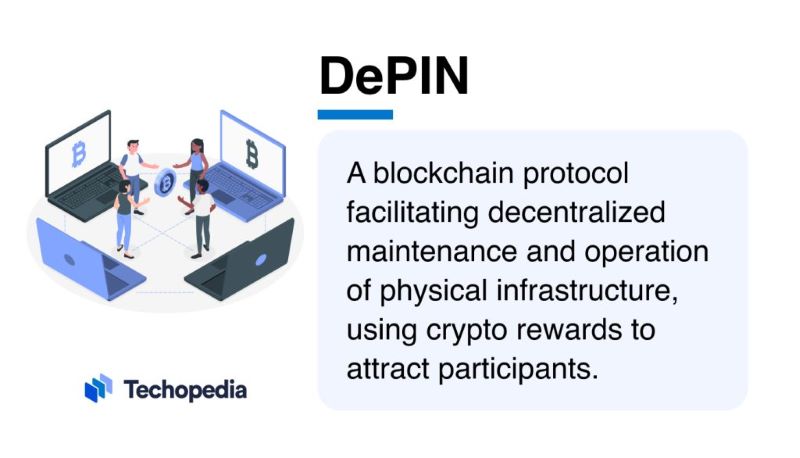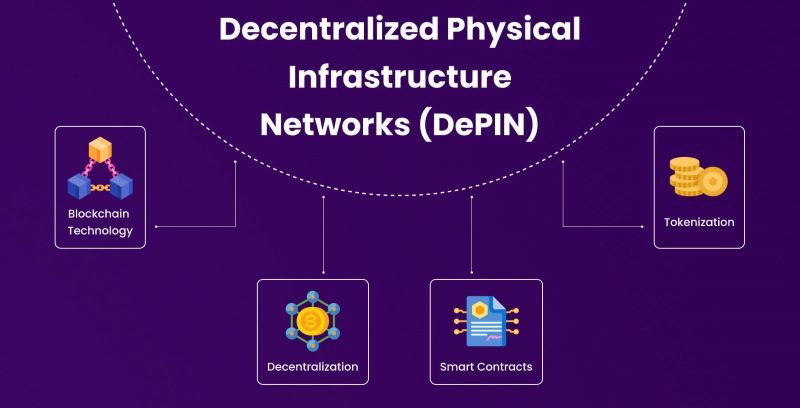Tired of Big Tech controlling your internet? Decentralized physical infrastructure network (DePIN) are putting power back in your hands. Click to discover how blockchain is revolutionizing access to essential resources.
What are Decentralized Physical Infrastructure Network (DePIN)?
Decentralized Physical Infrastructure Networks (DePINs) are blockchain-based protocols designed to revolutionize the way we build, manage, and interact with real-world infrastructure. They leverage the power of blockchain technology, cryptoeconomic incentives, and peer-to-peer networks to create open, transparent, and efficient systems for accessing essential resources and services.
DePINs are characterized by their decentralized nature, operating on networks without central intermediaries, empowering individuals with control over their resources. They utilize tokenization to represent physical assets as digital tokens on the blockchain, facilitating fractional ownership and easy value transfer.
Cryptoeconomic incentives, such as token rewards, encourage participation and ensure fair compensation for resource contributors. Additionally, DePINs leverage peer-to-peer networks for direct interaction and resource sharing, enhancing efficiency and reducing costs. Smart contracts automate processes within the network, promoting transparency and trust.
Explains the Decentralized physical Infrastructure Networks Meaning
A DePIN is a peer-to-peer (P2P) network that meets hardware demand through an open and decentralized marketplace.
Cryptocurrencies are at the center of DePIN community building. DePINs use crypto token rewards to attract and incentivize real-world physical infrastructure operators to join their networks.
When the value of a DePIN’s token rises (as investor capital enters the network), it enables service providers to offer competitive pricing. It leads to growth in adoption and demand for DePIN’s services, which ultimately leads to a further rise in token price, attracting more investors, service providers, and users.

A report by Messari categorizes DePINs into two groups: Physical Resource Networks (PRNs) and Digital Resource Networks (DRNs). This classification helps to better understand the diverse applications and potential impact of DePINs across various industries.
Physical Resource Networks (PRNs): focus on location-specific resources like energy grids, wireless connectivity, and environmental data collection.
Digital Resource Networks (DRNs): on the other hand, offer location-independent resources such as cloud computing, data storage, and bandwidth.
How does DePINs work?
DePINs operate through a three-pronged approach, utilizing off-chain networks, blockchain technology, and protocols.
The off-chain network comprises users and service providers. Users seeking resources like GPU computing power or data storage can purchase them from service providers in an open marketplace.
Blockchain technology acts as the bridge between users and providers, serving as a transparent and secure ledger for transactions and agreements. All interactions are recorded on-chain, ensuring transparency and traceability.
Protocols are the encoded rules governing the DePIN’s operation, determining aspects like security measures, token supply, provider eligibility, and interactions between users and providers. These protocols establish the framework within which the DePIN functions and evolves.
Why are Decentralized Physical Infrastructure Network needed?
DePINs are essential to address the limitations of centralized hardware infrastructure markets, which are currently dominated by large tech corporations. These decentralized networks empower end-users by eliminating the risk of censorship or service interruption that can occur under centralized control.
For instance, in the GPU market, individuals and small businesses often face difficulty accessing high-performance GPUs due to limited availability and prioritization of larger clients. DePINs offer a solution by creating open marketplaces where anyone can purchase these resources.
Furthermore, DePINs provide a more cost-effective alternative to traditional infrastructure providers. Their mature networks, backed by robust communities of service providers, offer competitive pricing and easy access, making them a viable option for those seeking affordable and reliable resources.
Overall, DePINs are needed to democratize access to essential hardware infrastructure, foster a more competitive and fair market, and empower individuals and small businesses with greater control over their technology resources.
DePINs are at the forefront of a technological revolution, leveraging blockchain’s power to democratize access to essential resources and services. By harnessing the collective resources of individuals and communities, DePINs are paving the way for a more equitable and resilient future.
Dive deeper into the world of DePINs and their potential to transform our lives. Subscribe to the Blockchain Bulletin Weekly newsletter for expert insights, in-depth analysis, and the latest news on this groundbreaking technology.
